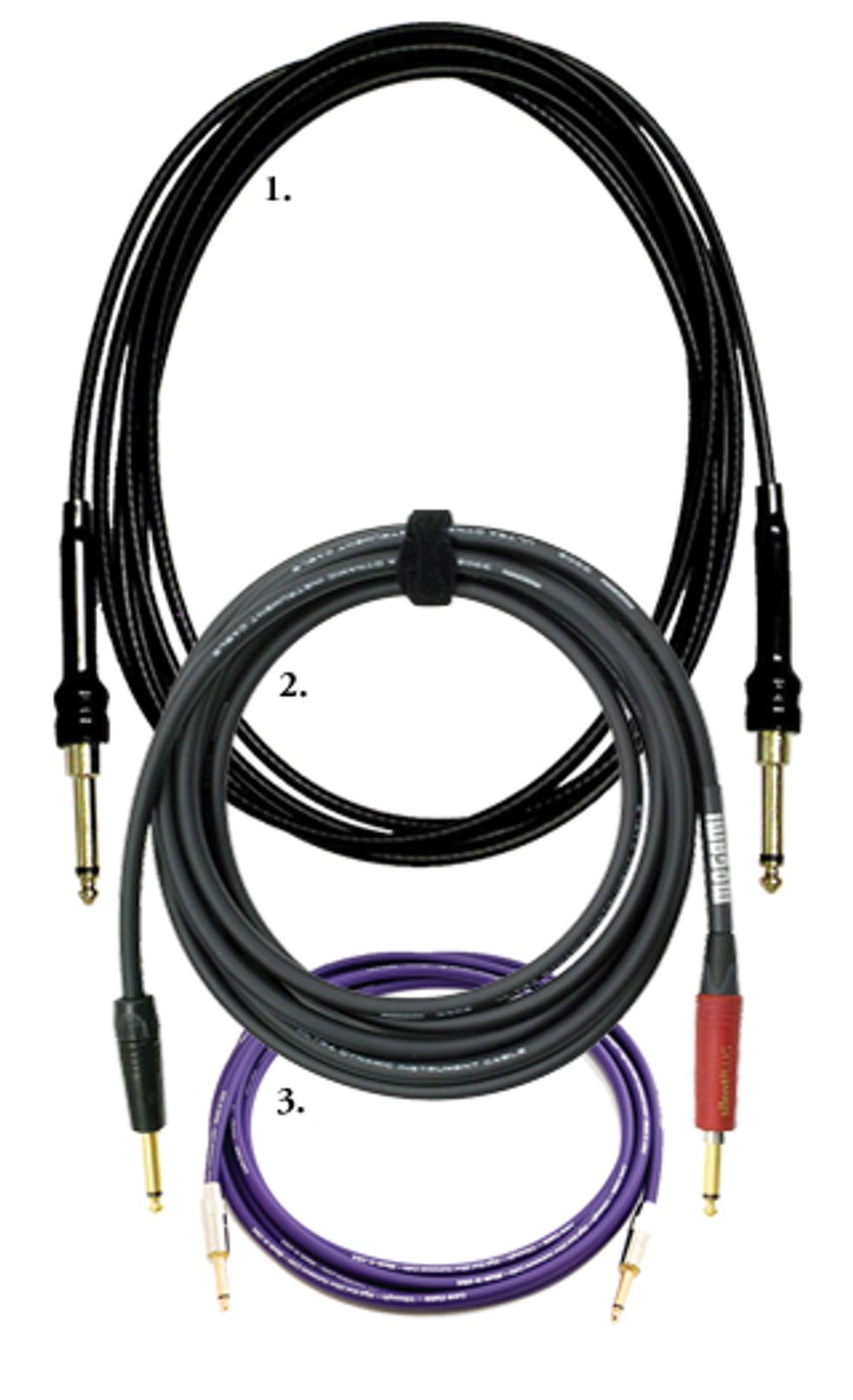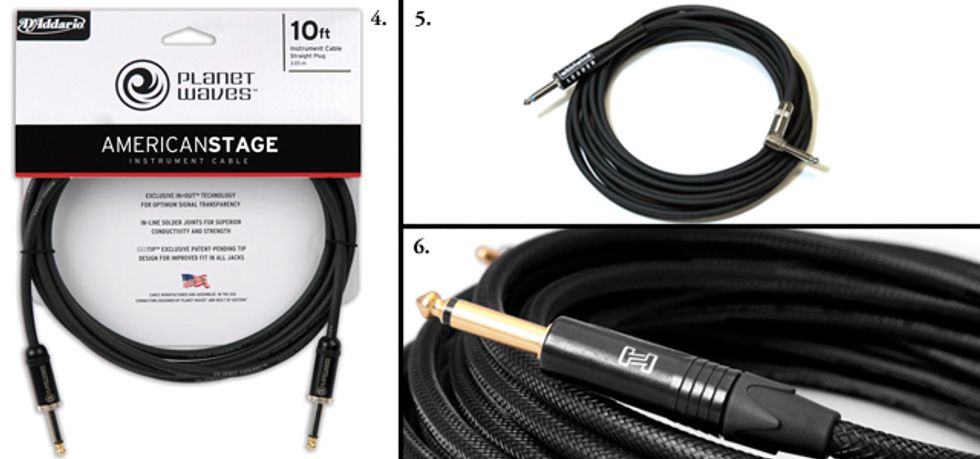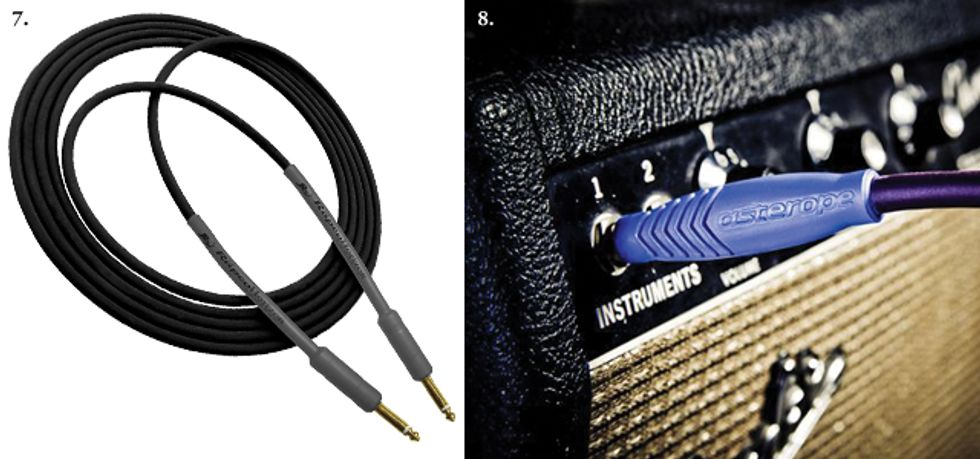If you’re like most guitarists and bassists, you probably started hoarding guitar cables pretty early on in your playing career. For decades now—probably since the dawn of electric guitar—many a basement jam has ended in cable-spaghetti chaos. Back in the day, you’d get home from the jam and later realize that the 10-foot Switchcraft you’d bought last month had somehow shape-shifted into an old Kordex Audible Purity, or vice versa. Like guitar picks, cables tended to change hands pretty easily because none of us really gave any consideration to how they sounded—all that mattered was that they worked. And the more you had, the better.
Back in the ’80s, we carried around knapsacks full of them—thick ones, thin ones, molded ones, coiled ones, long ones, short ones, and even the cheap Radio Shack knockoffs that at times seemed like they might have been more useful as shoelaces. Every once in a while, someone would splurge for a high-end professional model and prattle on for hours about how much cooler and deeper it made everything sound. The poor sap would bring it to rehearsal, plug in his Strat, crank it up and shout, “Hear that?” We’d just look at each other and shrug, knowing that eventually, that very same cable would make the knapsack rounds, too.
Slowly but surely though, over the last couple of decades, these attitudes have changed. Some attribute it to the advent of digital recording: As software grew more adept at delivering pristine, high-resolution audio, weak links in the signal chain began to stand out, creating a demand for instrument cables that were better at suppressing triboelectric noise (aka “handling noise”—clicks and pops, mostly) but that also didn’t EQ the sound of the guitar (a phenomenon that basically comes down to a cable’s capacitance, which we’ll get into in a minute). Meanwhile, as competition among cable manufacturers picked up and new companies joined the fray, design engineers started to dig more into research and analysis, all in a concerted effort to “build a better cable.”
As Jim D’Addario recalls, after D’Addario & Co. acquired the Planet Waves line in 1998, the focus was on problem solving—specifically, signal loss and degradation, handling noise, and connection failures. “We started measuring everything, because we wanted to find out what was there,” he says. “And we really didn’t play into EQ-ing the tone of your guitar before it hits your first pedal or your amplifier. If you’ve got great-sounding strings with a good pickup and a good cable, the signal should be pure and not doctored-up by pieces of equipment in the chain. When you get to your effects and your amplifier, that’s where you tailor your sound.”
These days, it no longer makes sense to consider your guitar cables as mere accessories. Materials, manufacturing processes, and design specs have evolved to such a degree that many seasoned axe-slingers swear they can hear—or at the very least detect—noticeable differences in signal response, transient harmonics, and dynamic range. Elite players have always endorsed specific brands because they heard something that appealed to them, but now more than ever, companies rely on constant feedback from their endorsees—and of course, their regular customers—in an effort to stand out in an increasingly competitive market.
For bassists and guitarists, it’s a great time to shop and experiment. The big names like Whirlwind, Planet Waves, George L’s, Hosa Technology (and its subsidiary, Zaolla Silverline), Mogami, and more have rolled out new cable lines or introduced significant upgrades in the past year, while young companies and recent mergers like Lava Cable, RapcoHorizon, and the Austin-based upstart Asterope continue to keep the big boys on their toes. We’d need a book-length study to get into an exhaustive roundup of what’s out there, but there are some key characteristics to look and listen for when choosing a solid and dependable cable in today’s market.

1. George L’s .225 Prepackaged 10' Cables ($38 street). 2. Mogami Platinum 12' Cable ($110 street). 3. Lava Cable Ultramafi c 12' Cable ($92 street)
The Capacitance Wars and
the “Sweet Spot”
Capacitance, measured in picofarads (pF),
began emerging as a buzzword in the late
’90s, and rightly so. It’s probably the single
most influential property that affects the
sound of a cable. Bill Lawrence—who
began designing pickups and guitars
for the likes of Fender, Gibson, Peavey,
and others in the 1950s, and who pioneered
solderless cables—explains why.
“The higher the capacitance of a cable,
the less highs reach the amplifier. High-capacitance
cables shift the resonance
towards the lower frequencies, which
dramatically alters tone. For example, Jimi
Hendrix used a coiled cord with 3,000
pF [of capacitance]. This was the secret of
Jimi’s tone: Shifting the resonance frequency
below 2,000 Hz on his Strats has a similar
effect to a midrange boost. When he
recorded and needed a typical Strat sound
for some tracks, Jimi switched to a short,
low-capacitance cable.” (This also brings up
a valuable corollary: The longer the cable,
the greater the capacitance—which is why
shorter cables always sound brighter.)
Among most manufacturers today, the consensus “sweet spot” for capacitance is between 20 and 30 pF per foot—a fraction of what Hendrix and his contemporaries had to wrangle. The reasoning comes from years of measurement, customer feedback, and plain old trial-and-error. “As I’ve designed my own cables, I’ve found that it’s really a balancing act,” says Lava Cable founder and CEO Mark Stoddard. “If you think of your guitar cable as a pipe—the lower the capacitance, the bigger the pipe—two things happen if you go too low: Your highs are out there longer, so the note won’t drop off in time and the guitar will sound shrill to most people. The other risk—and I learned this the hard way—is that the cable tends to be more microphonic. That’s literally because you can hear more.”
George Lewis, who founded George L’s in the ’70s and is widely credited with bringing the first low-cap, high-end guitar cables to market, apparently favored the lower (and thus brighter-sounding) end of the sweet spot. The company’s most prominent endorsee is Eric Johnson, whose crystalline clean tone seems naturally geared for the upper-mid accent that’s a signature of, for example, the George L’s .225 line of cable—a slightly heftier cable, in terms of weight and thickness, than the .155, which is sold as part of the company’s custom effects kit. (With solderless connections growing in popularity, it’s easier than ever for players to cut and assemble their own patch cables.) George L’s also sells bulk cable by the foot—another innovation that more companies are adopting.
Hosa Technology’s Elite Series model hovers around 21 pF, which theoretically places it in the sonic ballpark of George L’s. The same holds true for Mogami’s Platinum Series, but as Mogami cable is sometimes considered the Cadillac (or perhaps more aptly, the Lexus LFA) of premium guitar cables, similarities start to diverge with the pF rating. Hosa’s Elite can claim equal reductions in handling noise and even similar connectors made by Neutrik, but Mogami’s large-diameter cable is made with Neutrik’s Silent Plug, which cuts the signal out completely when changing instruments. There’s a clear aura of luxury to any Mogami product. However, at twice the price of some of its competitors, whether the high-end engineering and add-ons translate to noticeable differences in sound (more on this below) is in the ear of the beholder.
4. Planet Waves AmericanStage
Instrument
Cable 10’ ($19 street).
5. Whirlwind Leader Standard
L18R ($28 street).
6. Hosa Elite Guitar Cable
($44–$85 list).
Further up the capacitance ladder, the affordable Planet Waves American Stage cable targets a very specific 28 pF range. As a matter of philosophy, Jim D’Addario doesn’t see the need to go overboard with vastly different sonic flavors. “If you look back at the history of some of our competitors, they might have had a ‘lead guitar’ model and a ‘jazz’ model and whatever else, and essentially all they did was doctor the EQ by building different levels of capacitance into the cable and attenuating the highs. Do you really need to buy two $60 cables with different sounds when you can just change the tone on your amp? That’s something we wanted to address right from the beginning.”
Over at Lava Cable, Stoddard agrees in principle with this approach, at least as far as capacitance is concerned. To that end, Lava Ultramafic premium cable is rated at 25 pF and made with a silver-plated copper conductor at a slightly larger-than-normal 18 gauge, which Stoddard discovered gives the cable a “punchier” sound. But he’s also keenly aware that customer tastes can be wide-ranging and eclectic, and he tries to accommodate them whenever feasible.
“One guy may not like what another guy thinks is the bomb,” he explains, “but you still can recommend things. For example, coils are great for Fender amps, because Fenders are bright, and a 20-foot coil is equivalent to about a 30-foot cable in terms of accumulated capacitance, which makes the amp sound a little darker and more musical. Greg Koch has been using our coils for quite some time, and [Nashville whiz kid] Daniel Donato loves them.”
7. RapcoHorizon G5S Professional 20' ($29 street).
8. Asterope 15' ($149 street)
Along those lines, RapcoHorizon G5S Professional cable is an affordable 18-gauge model rated at 45 pF, so it falls into the darker end of the sonic spectrum. That said, the prevailing school of thought about higher- capacitance cables, as Bill Lawrence notes in his Hendrix example, is that they’re better suited for the rigors of live performance. This is especially true when considering the usual noisy ambience of a crowded venue, where the sonic nuances of low-capacitance premium cables tends to get lost.
In fact, this is exactly what Whirlwind’s Al Keltz told PG in 2008, but not because he believed such low-cap cables necessarily merited their premium price. “I agree that cables can and do have some effect on frequency response,” he said, partly in defense of the company’s stalwart Leader series, which to this day is a staple of rugged dependability on the road, “but unless the cable capacitance is extremely high, the effect will be subtle. These differences also become much less noticeable when you fire up the whole band and all sorts of sounds start interacting with each other onstage due to room resonances and comb filtering.”
This throws open the floor to all sorts of opinions about whether incremental changes in capacitance really can be heard—a discussion that gets even more potentially delicious when a new company like Asterope steps to the fore with what it maintains is a disruptive technology. “We want to create emotional experiences for artists and listeners,” says president and CEO Dariush Rad, “and help them deliver signals that are providing obvious and clear advances in harmonics and sonic characteristics—bandwidth, transient response, spectral balance—all these things that are very real and at the critical heart of making music. We know there are skeptics, but you can hear it and literally feel it with this technology. That’s what I want to share with every player I know.”
A respected record producer and engineer himself, Rad waxes almost poetic in his commitment to Asterope’s premium Pro Artist line, for example. Thus far, the company has kept its design specs very close to the vest, but the glowing praise from guitarists who endorse the cable—including David Grissom, Lance Keltner, and Kenny Vaughan (each a musician’s musician among Austin and Nashville cognoscenti)—suggests perhaps Asterope really is on to something different.
Materially Speaking
Once you get past capacitance, opinions
begin to deviate wildly about other aspects
of a cable’s design that might affect a guitar’s
signal characteristics. Some insist the
pure conductivity of the metals used to
make the 1/4" connectors plays a role in the
sound. Others get into a soldered vs. solderless
standoff, where a cold weld or a gas-tight
crimp might be the only acceptable
alternative to a good old-fashioned solder.
And still others would rather hang from a
ledge by their fingernails than admit that a
standard cable sounds the same no matter
which end you plug into the guitar.
One thing we can be sure about: Whether a cable is made with oxygen-free copper (OFC) or electrolytic-tough-pitch (ETP) “common” copper, it won’t help you sound like Eddie Van Halen. But a case can be made for high-quality materials having some influence on the sound, however minute, especially when considering conductivity.
“Whenever you increase the conductivity of the cable and lower its resistance, it typically sounds a little bit better,” Lava’s Stoddard asserts. “It’s not a whole lot, but it’s there.” He points to his Ultramafic cable, which is made with custom-shopped plugs from G&H (one of the main suppliers of parts, along with Neutrik, to American cable manufacturers). “The plugs have a silver core,” he explains, “so we literally replace about four inches of brass with silver, which is higher in conductivity and lower in resistance.”
Hosa Technology vouches for its premium Zaolla Silverline cables with a similar assertion, albeit with more detail. “While it is true that silver is superior to copper as a pure conductor of electricity, this is not to say that silver alone is suitable for every application. If it was that easy, we could simply replace copper with silver and be done with it! Low-level analog audio signals benefit from the MF [midrange frequency] boost, or ‘warmth,’ associated with copper. Thus, all Zaolla Silverline instrument cables feature a solid-silver center conductor and an enamel-coated, stranded-copper ancillary conductor in a unique hybrid configuration for the best of both worlds.” To some players, that complex explanation might sound a bit hard to prove, but then again that’s not exactly a new situation in guitardom. As with everything else in “the relentless pursuit of tone,” the only way to know for certain whether certain bits of minutia will make a difference in your sound is to test-drive a product yourself.
Of course, let’s not forget that quality parts and craftsmanship should also extend the life of the cable—and address long-standing design flaws whenever possible. Jim D’Addario points to one small innovation with the American Stage cable that was engineered as a solution to the wide variation in instrument jacks that often results in loose connections. “The tip of the plug is called a GeoTip, because the geometry of it is completely different,” he says. Basically, thanks to a slightly flattened bulb and an elongated shield, the newly designed tip enables a more secure connection with the positive flange of just about any jack, old or new. “It’s the kind of detail that looks like nothing, but we put hundreds of hours into designing and testing that sucker so we can cover enough of all the variations, and come up with a better connection for everybody. It’s very similar to putting a seat belt on [laughs]. When you here that clunk, it just goes in and you know it’s gonna stay there.”
In the End, Trust Your Ears
With so many choices at your disposal, it’s
easy to get overwhelmed when looking for
1/4" instrument and patch cables. But the
main thing to keep in mind is that a cable is
an integral part of your signal path, and that—just with everything else in the chain from
your instrument to your amp—you should
follow what you hear. No matter what your
philosophy about cables—if you like them flat
and uncolored, or with enough accumulated
capacitance to coil a python—just keep your
ears open, and you’ll find one that fits your
sound, your playing style, and your budget.
“To strip it down to the basics, signal
matters,” Rad says. “You’re spending a
lifetime honing your craft, and you’re
spending thousands of dollars on your rig,
so don’t underestimate how critical your
signal path is. We should be cradling that
like a baby, because that’s where all the
data is, y’know?”
And once you’ve got a handle on the data, feel free to take that baby out for a stroll. “Guitar players have freaky ears,” Stoddard quips. “We’re constantly tweaking sound, whether it’s a pedal or an amp or a guitar, and I think most of us have a sound in our head that we’re after. Everyone’s got something that they like, and your cable is an integral part of that. There are tone freaks out there who will take a brand new cable, no matter what kind it is, and they’ll plug it in back and forth, in two different directions over and over again, until they find the direction they think sounds best, and then they’ll mark it!
“What I still believe to this day, though, is if you find the cable you really like and that works in your rig, it opens up more tonal range in your amp and gives you more depth to work with. That’s the key lesson I’ve learned. If you do your research and play with a few cables and find that one you like, you literally have more room. I’m not a shredder, but I’m a digger, and if I’m digging in, I want to feel that note. I want to hear it freakin’ scream! A good cable can make a difference. It can help that note sustain better, and that’s not snake oil.”








![Rig Rundown: Russian Circles’ Mike Sullivan [2025]](https://www.premierguitar.com/media-library/youtube.jpg?id=62303631&width=1245&height=700&quality=70&coordinates=0%2C0%2C0%2C0)


























